Neasden
| Neasden | |
| Middlesex | |
|---|---|
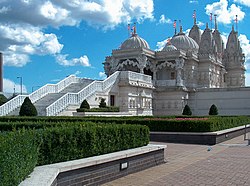 Neasden's Hindu temple. | |
| Location | |
| Grid reference: | TQ215855 |
| Location: | 51°33’19"N, 0°14’47"W |
| Data | |
| Post town: | London |
| Postcode: | NW2, NW10 |
| Dialling code: | 020 |
| Local Government | |
| Council: | Brent |
| Parliamentary constituency: |
Brent Central |
Neasden is a suburban area in the midst of Middlesex. It is considered a practical town rather than a pretty one known mainly for a London Underground depot and a large Hindu temple.
History
The area was recorded as Neasdun in 939: the name is derived from the Old English neos dun, meaning 'nose hill', which is to say a nose-shaped hill In 1750, it is recorded as Needsden: the present spelling appeared at a later date.[1]
Neasden was once a countryside hamlet on the western end of the Dollis Hill ridge and the land was owned by St Paul's Cathedral. In the Middle Ages the village consisted only of several small buildings around the green near the site of the present Neasden roundabout.
In the 15th–17th century the Roberts family were the major landowners in the area. Thomas Roberts erected Neasden House (on the site of the modern Clifford Court) in the reign of Henry VIII. In 1651 under Cromwell's Commonwealth, Sir William Roberts bought confiscated church lands. After the Restoration the estates were returned to the ownership of the Church but were leased out to the Roberts family. Sir William improved Neasden House and by 1664 it was one of the largest houses in the Willesden parish.
During the 18th century the Nicoll family replaced the Roberts as the dominant family in Neasden. In the 19th century these farmers and moneyers at the Royal Mint wholly owned Neasden House and much of the land in the area.
Neasden was no more than a ‘retired hamlet’ when enclosure was completed in 1823. At this time there were six cottages, four larger houses or farms, a public house and a smithy, grouped around the green. The dwellings include The Grove, which had been bought by a London solicitor named James Hall, and its former outbuilding, which Hall had converted into a house that became known as The Grange.[2]
The Welsh Harp reservoir was completed in 1835. It was breached in 1841, causing fatalities. The reservoir had a dramatic effect on the landscape as the damming of the River Brent put many fields and meadows underwater.
In the early 1850s, Neasden had a population of about 110. As London grew, the demand for horses in the capital soared in the second half of the 19th century. Neasden farms concentrated on rearing and providing horses for the city. Town work was exhausting and unhealthy for the horses, and in 1886 the RSPCA formed a committee to set up the Home of Rest for Horses with grounds in Sudbury and Neasden, where for a small fee town horses were allowed to graze in the open for a few weeks.
The urbanisation of Neasden began with the arrival of the railway.[3] The first railway running through Neasden — Hendon-Acton and Bedford — St. Pancras was opened for goods traffic in October 1868, with passenger services following soon. In 1875, Dudding Hill, the first station in the area, was opened, and the Metropolitan Railway was extended through Neasden shortly afterwards.[4] Neasden station was opened on Neasden Lane in 1880. New housing, initially for railway workers, was built in the village (particularly around Village Way) with all the streets named after Metropolitan Railway stations in Buckinghamshire. These survive today, and are called Quainton Street and Verney Street, followed by Aylesbury Street in the 1900s.[5]
In 1883, an Anglican mission chapel, St Saviour's, was set up in the village. Its priest, the Reverend James Mills, became an important and popular figure in late 19th century Neasden. In 1885 Mills took over St Andrew's, Kingsbury and became vicar of a new parish, Neasden-cum-Kingsbury, created because of the area's rising population.
Before Mill's arrival, the only sporting facilities in Neasden had been two packs of foxhounds, both of which had disbanded by 1857. Mills became founder president of Neasden Cricket Club and encouraged musical societies. In 1893 a golf club was founded at Neasden House, however only 10% of its members came from Neasden.
In the 1890s change led to a conscious effort to create a village atmosphere. At this time, the Spotted Dog became a social centre for local people. By 1891 Neasden had a population of 930, half of whom lived in the village. Despite the presence of the village in the west, it was the London end that grew fastest.
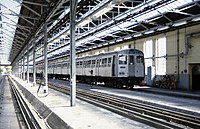
In 1893 the Great Central Railway got permission to join up its main line from Nottingham with the Metropolitan. Trains ran on or alongside the Metropolitan track to a terminus at Marylebone (this is now the modern day Chiltern Main Line). The Great Central set up a depot south of the line at Neasden and built houses for its workers (Gresham and Woodheyes roads). The Great Central village was a "singularly isolated and self-contained community" with its own school and single shop, Branch No. 1 of the North West London Co-operative Society. It is now part of a conservation area. There was considerable sporting rivalry between the two railway estates and a football match was played every Good Friday. By the 1930s the two railways employed over 1000 men.
Neasden Hospital was built in 1894 and closed in 1986.
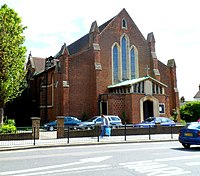
Apart from the railways, Neasden was dominated by agriculture until just before the First World War. In 1911, Neasden's population had swollen to 2,074. By 1913, light industry at Church End had spread up Neasden Lane as far as the station.
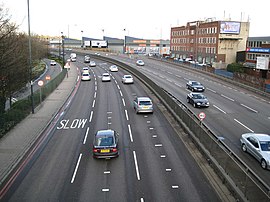
In the 1920s, the building of the A406 North Circular Road, a main arterial route round London, brought another wave of development; it opened in 1922–23. The 1924–25 British Empire Exhibition led to road improvements and the introduction of new bus services. Together with the North Circular Road, it paved the way for a new residential suburb at Neasden. In 1930 Neasden House was part demolished. The last farm in Neasden (covering The Rise, Elm Way and Vicarage Way) was built over in 1935. The Ritz cinema opened in 1935 and Neasden Shopping Parade was opened in 1936, and was considered the most up-to-date in the area. All of Neasden's older houses were demolished during this period, except for The Grange, and the Spotted Dog was rebuilt in mock-Tudor style. Industries sprung up in the south of the area, and by 1949, Neasden's population was over 13,000.
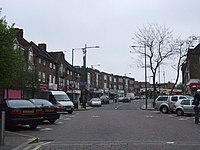
The Post Office Research Station was located nearby in Dollis Hill. There the Colossus computers, among the world's first, were built in 1943-1944 and underneath it the Paddock wartime cabinet rooms were constructed in 1939.
Neasden Power Station, which was built to provide power for the Metropolitan Railway, was closed and demolished in 1968.[6]
After the war, a new housing estate called St Raphael's Estate was built west of the North Circular Road and east of Wembley.
The post-war history of Neasden is one of steady decline; local traffic congestion problems necessitated the building of an underpass on the North Circular Road that effectively cut Neasden in half and had a disastrous effect on the shopping centre by making pedestrian access to it difficult. The decline in industry through the 1970s also contributed to the area's decline. But nonetheless Neasden has survived, largely due to a succession of vibrant immigrant communities keeping the local economy afloat. Neasden Depot continues to be the main storage and maintenance depot for the London Underground's Metropolitan line (and is also used by trains of the Jubilee line); it is London Underground's largest depot and as such it is a major local employer.
In 1995, Neasden became the home of the biggest Hindu temple outside India: the Neasden Temple.
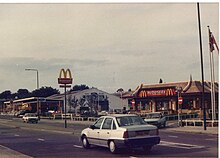 |
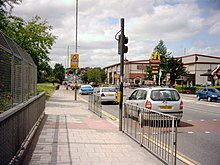 |
In 2004, the Shopping Centre area was partially redeveloped by the council in an effort to reverse its fortunes. The Grange, which had housed a community museum about the people of Brent was closed by the council in 2005. The building is now a restaurant with its namesake, located inside the Neasden roundabout.[7] The 2004 redevelopment proved to be unpopular with local businesses as it changed the layouts of parking, thus forcing customers and local trade to pass by due to the parking restrictions of the redevelopment.
An author for the New Statesman called Neasden a "prime example of what happens when a big road [North Circular] both carves up and strangles an area."[8]
Neasden in popular culture
Neasden was once nicknamed ‘the loneliest village in London’.[2]
Private Eye, the satirical magazine has ensured for Neasden considerable notoriety. Since early in its history (when the magazine was actually printed in Neasden) the magazine has used Neasden as an exemplar of the suburban environment in pieces parodying current events, personalities, and social mores (for example, the University of Neasden). Spoof sports reports in the magazine usually feature the perennially unsuccessful football team, Neasden F.C. with their manager, "ashen-faced" Ron Knee and their only two supporters, Sid and Doris Bonkers.
In Metro-land, a TV documentary narrated by Sir John Betjeman, Neasden was one of the locations visted, and Betjamin described it as "home of the gnome and the average citizen" (the former a reference to the preponderance of gnome statuettes in suburban front-gardens, but possibly also a nod in the direction of the Eye's fictional proprietor, Lord Gnome). Background music was provided by William Rushton’s recording of Neasden (1972) ("Neasden/You won’t be sorry that you breezed in").
In a celebrated spoof of the Early Music phenomenon which grew enormously in the late 1960s, Neasden was selected by BBC Radiophonic Workshop composer David Cain as the home of a fictional ensemble dedicated to historically-informed performances on authentic musical instruments from an indeterminate number of centuries ago. It was thus that in 1968, listeners to BBC Radio 3 were given a recital by the Schola Polyphonica Neasdeniensis whose members performed on the equally fictional Shagbut, Minikin and Flemish Clackett.[9]
Athletico Neasden was an amateur football team of mostly Jewish players, which played in the Maccabi (Southern) Football League in the 1970s and 1980s and was named after the place, though it did not actually play in the area. The team eventually merged with North West Warriors to form North West Neasden.[10] (See also — Son of Neasden and Neasden Academicals).
David Sutherland's children's novel A Black Hole in Neasden reveals a gateway to another planet in a Neasden back garden. Diana Evans's 2006 novel, 26a, details the experiences of twin girls of Nigerian and British descent growing up in Neasden.
A pirate radio station, Dread Broadcasting Corporation, credited as Britain's first black music radio station,[11] was broadcast from a Neasden garden between 1981 - 1984.
In the episode "Planet of the Machines", Dangermouse and Penfold arrive back in Neasden from the planet in the Baron's space time machine
References
- ↑ "Neasden, area in the London Borough of Brent". http://www.brent-heritage.co.uk/neasden.htm.
- ↑ 2.0 2.1 "Neasden - Hidden London". http://www.hidden-london.com/neasden.html.
- ↑ "Planning and building control - Brent Council". http://www.brent.gov.uk/planning.nsf/0/ac3a63699612b4c980256bb40055d4e4!OpenDocument.
- ↑ Neasden Station
- ↑ https://diamondgeezer.blogspot.com/2017/05/willesden.html
- ↑ Support, altcom. "404 - Page not found - London Transport Museum". http://www.ltmcollection.org/photos/themes/theme_sub.html?IXtoptheme=Power+stations&IXrefine=Neasden.
- ↑ Grange Neasden
- ↑ https://www.newstatesman.com/politics/uk/2018/08/dreams-don-t-come-neasden-die-they-could-never-have-lived-here-first-place
- ↑ Music matters - Hugh Newbury
- ↑ "Temple Fortune Football Club". http://www.tffc.co.uk/NewFiles/ripmsflclubs.html.
- ↑ "BBC - 1Xtra - Black History Month - 1980". https://www.bbc.co.uk/1xtra/bhm05/years/1980.shtml.